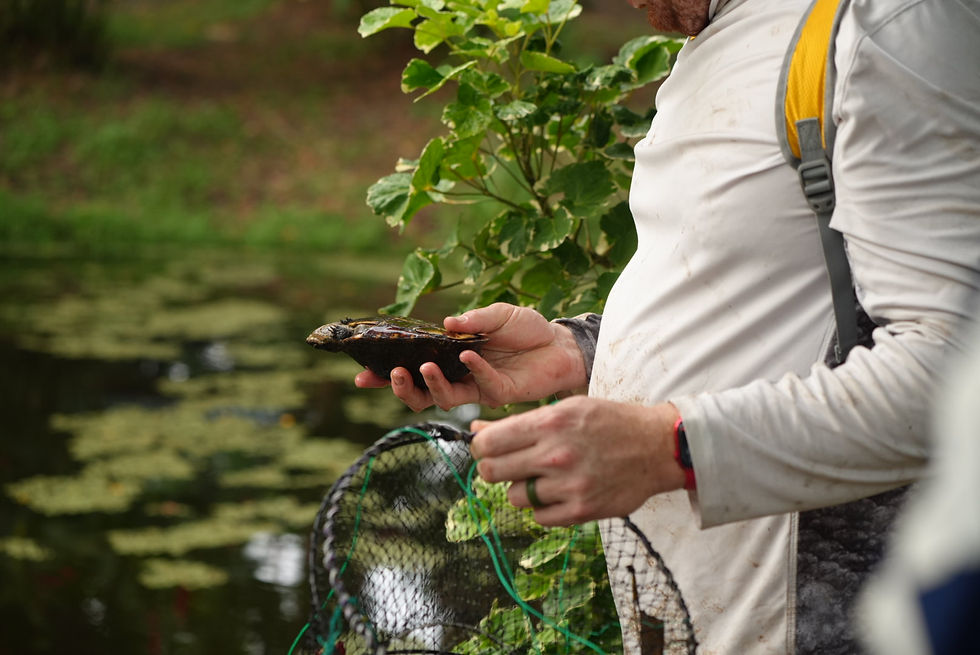Turtle Love: conserving sea turtles in Costa Rica
- dawnwildphotography

- Oct 17, 2024
- 3 min read
Updated: Jul 16
Would you wade through stagnant river water, swarmed by giant mozzies, fumbling through traps to find old tins of mackerel (and any other life form that happens to have found itself there), all in the name of research?
It turns out real conservation in Costa Rica does not involve cuddles with cute sloths (which is entirely unethical, by the way). It's much more onerous than that, but ever more rewarding. And it takes some seriously dedicated people, like those I met whilst volunteering with Turtle Love.

Uniting people with one common goal
After months of searching for a credible conservation project to support whilst travelling in Costa Rica, I was very excited to discover Turtle Love. A nonprofit conservation organisation, its mission is to "conserve sea turtles on the Caribbean coast of Costa Rica through community involvement, applied research, and liaison with environmental agencies." Based on Playa Tres in Parismina, just south of Tortuguero National Park, it is deeply rooted in community and a love for marine life. It attracts people from across the globe, with different cultural and professional backgrounds, uniting by a shared purpose to study and conserve turtles.
An unforgettable journey
But what's an experience, without an exhilarating journey to get there?! Getting to Tortuguero National Park is one of those truly unforgettable experiences that make the journey worthwhile. As there are no roads directly to the village, you need to travel by boat or plane. The quickest, and most fun, is flying from San Jose using one of the domestic carriers - Nature Air or SANSA (both have daily departures, flight time is around 30 minutes).
From the ocean to the river
The main objective of the non-profit is to monitor and protect sea turtles, but that's not to say freshwater turtles are any less important. In fact, there were two professors from Florida SouthWestern State College there during my stay, conducting research on the turtles residing in Tortuguero's river system. They were kind enough to allow me to participate in their data gathering, which involved accompanying them to collect traps (and whatever was caught in them), taking measurements and recording some vital stats, and checking radio tags.
Protecting endangered species from poaching
My main objective for being there, however, was to support with the protection of the endangered green turtle (Chelonia mydas). As a community-led organisation, Turtle Love set out to end the illegal poaching of eggs and adult turtles by encouraging economic alternatives to extractive use, such as ecotourism. By maintaining a presence on the beach through its monitoring program, they can discourage poaching in the short term—and by involving local community members in the conservation effort, they foster long-term behaviour change by increasing more sustainable income streams.
Thanks to sustained efforts by Renato Bruno and his team at Turtle Love, the population of nesting females in the area has increased in the last few decades. However, the areas adjacent still suffer from high levels of illegal harvesting, meaning that Turtle Love has had to extend its protection and monitoring to another 5 km of important nesting beach for endangered green, leatherback (Dermochelys coriacea), and critically endangered hawksbill (Eretmochelys imbricata) turtles.
An inspiration to us all / Una inspiración para todos nosotros
All of Turtle Love's work was incredibly motivating, and I really felt honoured to be part (even if small) of such a project. I was particularly inspired by one of the interns, Emmanuel Bello (Emma), a twenty year old biology student from Limón—who was completing an internship as a field assistant.
From the moment I met Emma, I could sense his unwavering passion for nature and conservation. Whilst my Spanish was not yet conversational, we somehow managed to find a way to understand each other. He taught me many things about conservation. From the practical—such as how to measure and identify different turtles, to the foundational—like true care and dedication for a cause much greater than ourselves.
He has made a significant impact at Turtle Love, leading groups of volunteers from all over the world and probably saving more than 20,000 baby sea turtles. He has an incredibly promising career ahead of him, one that will impact the lives of many—human or otherwise! You can read his full story, and contribute to his college education, here.






















Comments